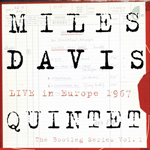|
|
 |
Dusted Reviews
Artist: Miles Davis Quintet Album: Live in Europe 1967: The Bootleg Series, Vol. 1 Label: Columbia Review date: Oct. 14, 2011 |

|
|
|
 |
More Miles Davis? Columbia has already given us the albums, the re-mastered albums, the SACD versions of some of the albums, the boxed sets organized around key albums, and the big honking box with nearly every official Columbia release. And now we get this, the first in a proposed series of officially sanctioned bootlegs. Cops and electronic surveillance personnel work for The Man; slavish Miles Davis collectors work for Columbia’s owner, Sony. At least the decline in fortune of the CD format has made it cheaper to be such a collector. Five years ago, when I reviewed the On The Corner box, the cost for six CDs was $120. This three-CD, one-DVD set will set your back $32.
And then there’s the question of whether we really need to hear more Miles. He’s been gone a couple decades now, and some might argue that the money sent making a box like this would be better spent sponsoring living musicians making living music. But we all know that Columbia isn’t going to do that anyway. And however much one might object to the “great man” view of jazz history codified by that Ken Burns documentary, Miles was special. He was involved in most of jazz’s momentum-generating movements between World War II and the fall of Saigon, and brought a conceptual intelligence and an awareness of process to his work that makes individual segments of his timeline worth considering as part of a grand whole. This particular ensemble, which comprised saxophonist Wayne Shorter, drummer Tony Williams, bassist Ron Carter and pianist Herbie Hancock, has already been aggressively documented. Between 1964 and 1968, they made a string of celebrated studio albums, from E.S.P. to Miles in the Sky, as well as a live record, Live At The Plugged Nickel, that eventually swelled into a currently out-of-print seven-CD set. The Plugged Nickel set is justifiably legendary for the way it documented a jazz group at the height of its powers disassembling and reinventing its material night by night. What can this collection add?
For a start, a chance to hear the band playing some of the exquisite, open-ended tunes from their studio albums. Although they had already recorded extensively by the time they played at The Plugged Nickel in December 1965, in concert they were still playing standards that Miles had leaned on for the past decade. By the time they played Europe in the fall of 1967, “Masqualero,” “Footprints” and “Riot,” each composed by Shorter or Hancock, had taken their place alongside “’Round Midnight” and “I Fall In Love Too Easily.” It’s also a chance to hear the band just before it came apart. In 1968, Hancock, Carter and Williams all left, and increasing experimentation with electric instruments relegated the sound of this ensemble to memory. Miles would never play this music again, and when the rest of them got together to play it without him, it was never the same.
It’s a bit of a stretch to call these recordings bootlegs, although some sketchy packaging decisions — really guys, is it that hard to find a place in the digipak for the booklet? —supply a simulacrum of that old grey market experience that you just can’t get by illegally downloading a live performance. The music on the CDs was recorded for radio broadcast, and the sound is just fine. The two TV appearances on the DVD are in mono and black and white, and the bass is a little anemic. But it’s still a blast to see these guys up close and marvel at Miles’ attitude, Williams’ youth, and the quintet’s improvisational fearlessness. But seeing these guys done up in tuxes, and hearing Miles revise “’Round Midnight” with a Sinatra-like staccato flourish, tells you why this band had to change. In 1967, the way you dressed declared whose side you were on, and these guys were not lined up with the cutting edge. They were at the acme of their art, but the scene around them was changing.
But what a way to go out! Packaging quibbles aside, this is a great set. Shorter is right on the tipping point between burgeoning invention that had taken him from Art Blakey’s Jazz Messengers into this quintet in the first place, and the increasing reticence that would characterize his work with Weather Report. Hancock and Carter spin lyrical fantasias at the same time that they hold this stuff together. Williams simultaneously drives the music and does his best to take it apart. And Miles is in top technical form, engaged with everything happening around him, yet ready to show the way both forward and back. This period of his music is at once accessibly beautiful yet vibrantly creative, and no one who has tried to copy it has ever been able to resurrect its spirit.
By Bill Meyer
|







